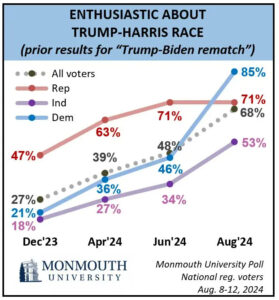Do Democrats need an actual landslide to win at all? The question arises from two disturbing possibilities.
- The Trump campaign, likely in league with Putin, will surely try to steal the election. We have already seen a massive influx of GOP laws to gain control of the count put in place in various states. They have all but announced it. In addition, new evidence of Russian meddling in our election machinery has resurfaced, which is not exactly a shocker, but it does merit more attention.
- Even if Dems narrowly win the presidency, they could fail to win both houses of congress, rendering them all but impotent with respect to enacting anything substantial on their agenda. The best antidote for this outcome is a Democratic landslide – to win so big that Trump and the cat-lady hater are washed away in a cleansing blue tsunami. Easier said than done, but it could happen
Although most pundits are saying it’s a toss-up, Harris-Walz are scoring well in polls, so far dodging major screw-ups. They are the fresh faces in this race, while the GOP ticket marinates in their increasingly bitter take on America. Harris’s youthful persona, Walz’s authentic middle class narrative and their ticket’s exuberant spirit have flipped the script; Growing numbers of likely voters see the GOP ticket as stale, tired and angry. Many of Trump’s own appointees have turned against him. Careerists RFK, Jr. and Tulsi Gabbard add to the GOP ticket’s “It’s all about me” vibe. The Republican campaign now has an aging preppy’s bilious ‘get-off-my-lawn’ spirit. Not a good look.
Democrats should amp up messages like”Harris-Walz for a More Joyful America,” “Let’s Move On – Harris-Walz 2024,” or “Trump Is So Yesterday.” Just underscore the glaring reality that only one party’s leaders are pointing the way forward to a more hopeful future for all Americans, while the other party’s leaders wallow in a whining personality cult. As a result, poll numbers show a trend away from Republicans, toward Democrats. Democratic activist James Carville put it well in a recent NYT op-ed, “The most thunderous sound in politics is the boom of a single page as it turns from one chapter to the next.”
The current Republican Party is more concerned with stroking Trump’s fragile ego than representing conservative causes. The only fix leading to a healthier Republican Party is a Democratic landslide. Only then is there a chance that they will finally get the message they missed during almost two years of electoral defeats. A few Republican leaders, including former U.S. Reps. Liz Cheney and Adam Kitzinger have figured out that defeating Trump decisively is the only way they can save their party, and they have endorsed Harris-Walz.
Democratic campaigns should understand that policy voters have already chosen sides. From now on, it’s all about the image that each party communicates to swing voters. For now, at least, advantage Democrats. Above all, hold that edge.






